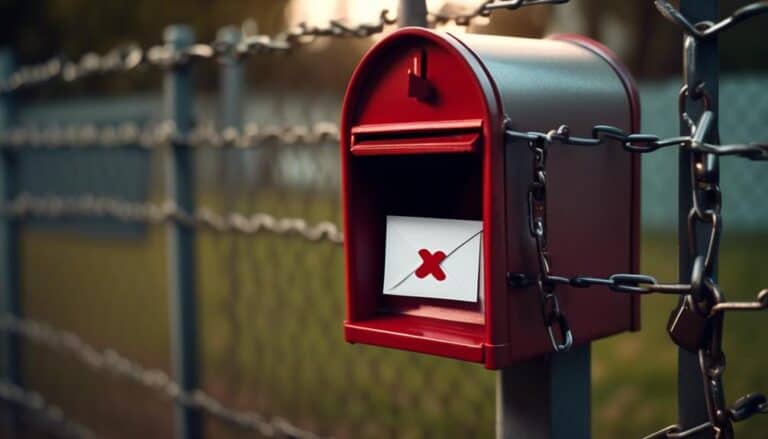Master the Art of Boosting Your Email Sender Reputation Today
Are your emails constantly ending up in the spam folder, never to be seen by your intended recipients? It's time to master the art of boosting your email sender reputation and ensure that your messages land right in the inbox.
In today's fast-paced digital world, where email marketing is a vital tool for businesses, understanding and improving your email sender reputation is crucial. But where do you start? How do you navigate the complex world of email deliverability and ensure that your messages are not only delivered but also opened and engaged with?
Stay tuned as we unravel the secrets to maximizing your email sender reputation and skyrocketing your email marketing success.
Key Takeaways
- Regularly monitor email metrics like open rates, click-through rates, and unsubscribes to assess sender reputation and engagement.
- Implement email authentication protocols like SPF, DKIM, and DMARC to enhance deliverability and protect against spam risks.
- Maintain a clean email list by removing inactive or unengaged subscribers, monitoring and removing bounced emails, and implementing segmentation.
- Personalize email campaigns through segmentation, dynamic content, and triggered emails to increase open rates and establish a reputable sender profile.
Understand the Importance of Email Sender Reputation

Understanding the importance of your email sender reputation is crucial for ensuring the deliverability and effectiveness of your email marketing campaigns. Assessing reputation management and recognizing the impact it has on your email marketing success is key to achieving your goals.
Your email sender reputation serves as a reflection of your brand's credibility and trustworthiness. Internet service providers (ISPs) and email service providers (ESPs) evaluate your reputation to determine whether your emails should be delivered to recipients' inboxes or marked as spam. A positive reputation increases the chances of your emails reaching the intended recipients and increases the likelihood of them being opened and engaged with.
Your reputation is influenced by various factors, such as the quality of your email list, the engagement levels of your subscribers, and the number of complaints or spam reports received. By actively managing your reputation, you can improve the deliverability of your emails and enhance the overall success of your email marketing campaigns.
To assess your reputation management, regularly monitor key metrics such as open rates, click-through rates, and unsubscribes. Pay attention to any warning signs that may indicate a decline in your reputation, such as a sudden drop in engagement or an increase in spam complaints. Taking proactive measures to address these issues can help you maintain a positive sender reputation and optimize the effectiveness of your email marketing efforts.
Assess the Current State of Your Sender Reputation
To assess the current state of your sender reputation, you need to evaluate key performance metrics and monitor any warning signs of a decline in engagement or an increase in spam complaints. By regularly assessing your reputation metrics, you can identify areas for improvement and take necessary steps to enhance your sender reputation.
Here are four important factors to consider when assessing your reputation metrics:
- Delivery Rate: This metric measures the percentage of emails that successfully reach the recipient's inbox. A high delivery rate indicates a positive sender reputation, while a low rate may signify deliverability issues.
- Open Rate: The open rate measures the percentage of recipients who open your emails. A high open rate indicates that your emails are engaging and relevant to your audience, while a low rate may suggest that your emails are being ignored or sent to spam folders.
- Click-through Rate: The click-through rate measures the percentage of recipients who click on the links in your emails. A high click-through rate indicates that your content is compelling and effectively drives engagement.
- Complaint Rate: The complaint rate measures the percentage of recipients who mark your emails as spam. A low complaint rate is crucial for maintaining a good sender reputation, as high complaint rates can lead to deliverability issues.
Implement Proper Email Authentication Protocols

To boost your email sender reputation, it's crucial to implement proper email authentication protocols. This includes using SPF (Sender Policy Framework), DKIM (DomainKeys Identified Mail), and DMARC (Domain-based Message Authentication, Reporting, and Conformance).
Authentication is important because it verifies that the email is coming from a legitimate source, reducing the chances of your emails being marked as spam or phishing attempts.
SPF, DKIM, DMARC
Boost your email sender reputation by implementing proper email authentication protocols such as SPF, DKIM, and DMARC. These protocols play a crucial role in improving your email deliverability and maintaining a positive email reputation. Here's why they're essential:
- Sender Policy Framework (SPF): SPF allows you to specify the authorized senders for your domain, preventing spammers from using your domain to send fraudulent emails.
- DomainKeys Identified Mail (DKIM): DKIM adds a digital signature to your emails, verifying their authenticity and ensuring they haven't been tampered with during transit.
- Domain-based Message Authentication, Reporting & Conformance (DMARC): DMARC combines SPF and DKIM to provide additional protection against email spoofing and phishing attacks. It allows you to specify how email providers should handle emails that fail authentication.
- Benefits: Implementing these authentication protocols enhances your email deliverability, reduces the risk of your emails being marked as spam, and builds trust with your recipients, ultimately improving your email reputation management.
Importance of Authentication
Implementing proper email authentication protocols is crucial for enhancing your email deliverability and maintaining a positive email reputation. By implementing email authentication, you can ensure that your emails are not only delivered to the recipient's inbox but also appear trustworthy and legitimate. This helps to build trust with your audience and establishes your brand as a reliable sender.
To help you understand the benefits of email authentication and the best practices for implementing it, here is a table that summarizes the key points:
| Email Authentication Benefits | Best Practices for Email Authentication |
|---|---|
| Increases email deliverability | Implement SPF, DKIM, and DMARC protocols |
| Builds trust with recipients | Regularly monitor and update authentication records |
| Reduces the risk of email spoofing | Use strong encryption and secure email servers |
| Protects your brand reputation | Educate your team on email authentication best practices |
| Ensures compliance with industry standards | Seek professional guidance if needed |
Implementing Email Authentication
Enhancing your email sender reputation begins with implementing proper email authentication protocols. By ensuring that your emails are authenticated, you can improve your email deliverability and strengthen your email reputation management.
Here are four key steps to implementing email authentication:
- Sender Policy Framework (SPF): Set up SPF records to specify which servers are authorized to send emails on behalf of your domain. This helps prevent email spoofing and strengthens your email authentication.
- DomainKeys Identified Mail (DKIM): Implement DKIM to add a digital signature to your emails, verifying their authenticity and integrity. This helps build trust with email providers and improves your email deliverability.
- Domain-based Message Authentication, Reporting, and Conformance (DMARC): Use DMARC to define policies for how email providers should handle emails that fail SPF or DKIM checks. This allows you to monitor and control your email authentication process effectively.
- Bounce Handling and Feedback Loops: Regularly monitor bounce rates and unsubscribe requests. Use feedback loops provided by email providers to identify and address any reputation issues promptly.
Maintain a Clean and Engaged Email List

Regularly cleaning and engaging your email list is crucial for maintaining a strong sender reputation. By implementing clean email practices and cultivating an engaged subscriber base, you can ensure that your emails are reaching the right audience and driving meaningful interactions.
To maintain a clean email list, it's important to regularly remove inactive or unengaged subscribers. These are individuals who haven't opened or clicked on your emails in a long time. By removing them, you can improve your email deliverability and avoid sending messages to uninterested recipients. Additionally, regularly monitoring your email list for bounced emails and removing them can also help improve your sender reputation.
Engaging your subscribers is equally important. When your audience is actively interacting with your emails, it signals to email service providers that your messages are valuable and relevant. This can lead to improved deliverability rates and higher engagement metrics. Consider implementing strategies such as personalized content, targeted segmentation, and interactive elements to encourage subscriber engagement.
By maintaining a clean and engaged email list, you can enhance your email sender reputation and increase the chances of your emails reaching the inbox. Use the table below as a guide to help you keep track of your email list maintenance efforts:
| Email List Maintenance Tasks | Frequency |
|---|---|
| Remove inactive subscribers | Monthly |
| Monitor and remove bounces | Weekly |
| Implement segmentation | Quarterly |
| Personalize email content | Ongoing |
| Monitor engagement metrics | Monthly |
Personalize Your Email Campaigns for Better Engagement
To take your email list maintenance efforts to the next level, consider personalizing your email campaigns to boost engagement and drive meaningful interactions. By improving personalization, you can increase open rates and create a stronger connection with your audience.
Here are four tips to help you achieve better engagement:
- Segment your email list: Divide your subscribers into smaller groups based on their interests, demographics, or past interactions. This allows you to tailor your content to each segment's preferences, increasing the chances of them opening and engaging with your emails.
- Use dynamic content: Dynamic content allows you to create personalized email experiences by displaying different content based on the recipient's data or behavior. Whether it's inserting their name in the subject line or showcasing products they've shown interest in, dynamic content makes your emails more relevant and engaging.
- Personalize subject lines and preview text: Craft subject lines and preview text that grab attention and make your subscribers feel seen. Incorporate personalization tokens such as their name or location to make the email feel more tailored to them.
- Send triggered emails: Triggered emails are automated messages that are sent based on specific actions or events, such as abandoned carts or birthdays. These emails are highly relevant and timely, increasing the likelihood of engagement and conversion.
Monitor and Respond to Email Deliverability Issues

Be proactive in monitoring and addressing any email deliverability issues to ensure that your messages reach your recipients' inboxes effectively.
Monitoring your email deliverability is crucial because it allows you to identify and resolve any issues that may be hindering the success of your email campaigns. One way to improve email open rates is to optimize your email subject lines. A compelling subject line can grab your recipients' attention and entice them to open your email. Make sure your subject lines are concise, clear, and relevant to the content of your email. Avoid using spam trigger words and excessive punctuation, as these can negatively impact your deliverability.
Additionally, regularly check your email deliverability metrics, such as bounce rates and spam complaints, to identify any potential problems. If you notice a decrease in deliverability or an increase in complaints, take immediate action to investigate and resolve the issue. This may involve reaching out to your email service provider for assistance or implementing changes to your email sending practices.
Avoid Common Email Sender Reputation Pitfalls
Are you struggling to get your emails past spam filters and into your recipients' inboxes?
In order to avoid common email sender reputation pitfalls, it's important to understand how spam filters work and how they impact deliverability.
By using reputation monitoring tools, you can keep a close eye on your sender reputation and quickly address any issues that may arise.
Building a positive reputation takes time and effort, but it's crucial for ensuring that your emails reach their intended audience.
Spam Filters and Deliverability
Avoiding common email sender reputation pitfalls is crucial for improving your deliverability and bypassing spam filters. Spam filters are designed to protect users from unwanted or malicious emails, but they can sometimes mistakenly flag legitimate messages as spam.
To ensure your emails reach the intended recipients' inboxes, follow these tips:
- Build a reputable sender profile: Maintain a good sending reputation by consistently sending relevant and engaging content to your subscribers. Avoid using deceptive tactics or sending unsolicited emails.
- Monitor your email deliverability: Regularly check your email deliverability metrics to identify any issues that may be affecting your sender reputation. Keep an eye on bounce rates, spam complaints, and unsubscribe rates.
- Use email authentication: Implement email authentication protocols like SPF, DKIM, and DMARC to verify the authenticity of your emails. This helps prevent spoofing and improves your chances of bypassing spam filters.
- Optimize your email content: Avoid using spam trigger words, excessive punctuation, or misleading subject lines. Personalize your emails and provide valuable content to engage your subscribers and reduce the chances of your emails being marked as spam.
Reputation Monitoring Tools
To effectively monitor and address common pitfalls that can affect your email sender reputation, utilize reputation monitoring tools. These tools provide valuable insights into your reputation management and help ensure optimal email deliverability. By using these tools, you can proactively identify and resolve any issues that may arise, maintaining a good sender reputation and maximizing the chances of your emails reaching the intended recipients.
Here is a table showcasing some popular reputation monitoring tools:
| Tool Name | Features |
|---|---|
| SenderScore | Measures your email reputation score |
| Barracuda Central | Monitors IP reputation and email deliverability |
| Return Path | Provides email deliverability insights |
These tools offer comprehensive reporting and analysis, allowing you to monitor your sender reputation in real-time and make necessary adjustments to improve your email deliverability. With the right reputation monitoring tools at your disposal, you can stay ahead of potential issues and maintain a strong sender reputation.
Building a Positive Reputation
Boost your email sender reputation by steering clear of common pitfalls that can harm your reputation. Building a positive reputation is essential for building trust and increasing engagement with your email recipients.
Here are four key strategies to help you achieve this:
- Send relevant content: Tailor your emails to the interests and preferences of your subscribers. By delivering valuable and personalized content, you'll demonstrate that you understand their needs and establish yourself as a trusted source of information.
- Maintain a clean email list: Regularly clean your email list by removing inactive or unengaged subscribers. This won't only improve your deliverability but also ensure that you're targeting an audience genuinely interested in your emails.
- Implement double opt-in: Require subscribers to confirm their email address to join your mailing list. This extra step helps verify the legitimacy of your subscribers and reduces the chances of spam complaints.
- Monitor email metrics: Keep an eye on your email open rates, click-through rates, and unsubscribe rates. Analyzing these metrics will provide insights into your subscribers' engagement levels and allow you to make necessary adjustments to improve your email campaigns.
Build Trust and Credibility With Your Email Subscribers
Building trust and credibility with your email subscribers is vital for maintaining a strong sender reputation. When your subscribers trust you and perceive your emails as credible, they are more likely to open and engage with your messages. This can lead to improved open rates and ultimately build stronger relationships with your audience.
To build trust and credibility with your email subscribers, consider the following strategies:
| Strategies to Build Trust and Credibility | ||
|---|---|---|
| 1. Provide Valuable Content | 2. Personalize Your Emails | 3. Be Transparent and Authentic |
| Share informative and relevant content that adds value to your subscribers' lives. | Address your subscribers by name and tailor your emails to their preferences and interests. | Be honest and genuine in your communication. Avoid deceptive tactics or misleading subject lines. |
Continuously Improve and Adapt Your Email Marketing Strategy

Are you looking for ways to continually enhance and adapt your email marketing strategy for optimal results? The key to a successful email marketing campaign lies in constantly improving and adapting your approach.
Here are four essential steps you can take to boost your open rates and optimize your subject lines:
- Analyze and learn from your data: Take the time to review your email metrics and identify patterns. Look for trends in open rates, click-through rates, and conversions. Use this information to understand what resonates with your audience and tailor your content accordingly.
- Test different subject lines: Your subject line is the first thing your subscribers see, so it's crucial to make it compelling and engaging. Experiment with different subject lines to see what works best. A/B testing allows you to compare the performance of different options and make informed decisions.
- Personalize your emails: People crave personal connections, so make an effort to customize your emails based on your subscribers' preferences and behaviors. Segment your email list and create targeted campaigns that speak directly to different groups of recipients.
- Stay up to date with industry trends: The email marketing landscape is constantly evolving, so it's essential to stay informed about the latest trends and best practices. Subscribe to industry newsletters, follow influential marketers, and attend webinars or conferences to stay ahead of the game.
Frequently Asked Questions
How Can I Check My Current Email Sender Reputation?
To check your email sender reputation, use online tools like SenderScore or BarracudaCentral. These services analyze your email deliverability and provide insights on how to improve your reputation. Start monitoring today!
What Are Some Common Email Authentication Protocols That I Should Implement?
To boost your email sender reputation, it's important to implement common email authentication protocols. These protocols ensure the authenticity and legitimacy of your emails, increasing deliverability and reducing the chance of being marked as spam.
What Are the Best Practices for Maintaining a Clean and Engaged Email List?
To maintain a clean and engaged email list, start by implementing email segmentation and regularly cleaning out inactive or bounced email addresses. This will improve deliverability and ensure your messages reach the right people.
How Can I Personalize My Email Campaigns to Improve Engagement?
To personalize your email campaigns and improve engagement, consider using personalization strategies such as segmenting your audience and addressing them by name. Additionally, measure the effectiveness of your campaigns through metrics like open rates and click-through rates.
What Are Some Common Email Deliverability Issues and How Can I Address Them?
Are your emails not reaching their destination? Common email deliverability issues like spam filters and high bounce rates can hinder your success. Discover how to address these issues and improve your email delivery today.
Conclusion
So, there you have it! By mastering the art of boosting your email sender reputation, you can ensure that your emails reach the right inbox and engage your subscribers effectively.
Remember to assess your current reputation, implement proper authentication protocols, maintain a clean email list, personalize your campaigns, monitor deliverability issues, and build trust with your subscribers.
Continuously improving and adapting your email marketing strategy will help you stay ahead in the game.
Happy emailing!








